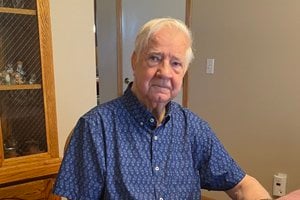CAGB Procedure Reenergizes Patient With Coronary Artery Disease
 William Lita, 88, knew there was something off with his health when he continually felt a loss of energy and couldn’t accomplish his normal, everyday tasks.
William Lita, 88, knew there was something off with his health when he continually felt a loss of energy and couldn’t accomplish his normal, everyday tasks.
“It was like after a workout,” said William. "You're working out and, suddenly, there's no energy and you can't do it anymore. Your arms get heavy, your legs get heavy, and it's like, wow. And then it would go away and then it would come back again.”
As a bladder cancer survivor, he knew the best choice for his long-term health was to tell someone what he was experiencing.
“Don’t be afraid to talk about your problems," William said. "Maybe you told 10 people, and 10 people didn’t listen, but you’ll talk to that 11th person who does listen and could help you. But if nobody knows about your problems, and they don’t know how you feel, then they can’t help you.”
William decided to go to MercyCare North Urgent Care. The provider treating him suspected something more serious and William was immediately taken by ambulance to Mercy Medical Center, where he met Cardiothoracic & Vascular Surgeon C.C. Lee, MD, FACS.
Dr. Lee diagnosed William with coronary artery disease (CAD), the most common type of heart disease and a leading cause of death worldwide. CAD occurs when plaque builds up and narrows the arteries of the heart. This limits the amount of oxygen-rich blood to the heart muscle. In William’s case, four of his arteries were partially blocked.
Dr. Lee recommended coronary artery bypass graft (CABG) triple bypass surgery – a procedure used to treat CAD in which the blocked or narrowed arteries are bypassed with a piece of healthy blood vessel from elsewhere in your body, like the chest or leg. One end of the graft is attached above the blockage and the other below the blockage. Blood then avoids the blockage by going through the new blood vessel to reach the heart muscle.
“In William’s case, CABG triple bypass surgery was the best option," Dr. Lee said. "Despite his previous cancer diagnosis, as well as his age, William was in otherwise good health.”
William woke up from the surgery and immediately started working toward recovery. Then, after the surgery, William experienced insomnia. His care team reassured him that it was sometimes a temporary side effect of the operation and made sure he knew they were there to help him through any problem, providing The Mercy Touch. After a few weeks, William was able to rest and started to feel much better.
While in the hospital, William was impressed with the coordination of care by his care team.
“I found that if I told a nurse I had this little problem, later in the morning when the doctors would round, [the doctors] would tell me exactly what I told the nurse,” William said. “It was good to know they all communicated so well, and everything was coherent. I knew I was in good hands."
Through his recovery both at the hospital and at home, William’s attitude was always positive. He never gave up or felt like he wasn’t going to make it through the process. He continually did the work to go home with a positive attitude.
“I didn’t want to burden my wife or anyone else in the family,” said William. “So, my attitude was to listen; to do what they tell you; and I did, I listened to them. If I took my attitude and graded it, I'd give myself a 100.”
Dr. Lee agreed: “The surgery William had is a major procedure. William’s positive mindset and dedication to his post-operative care helped him rehabilitate quickly. And I always tell patients afterwards, you have to think positive to get better because the surgery is a hurdle. You have to have a positive mindset when you go into surgery.”
Now, William is feeling great and looking forward to spending time with his family in the years to come.
To learn more about Mercy’s Heart Center, visit www.mercycare.org/heart.